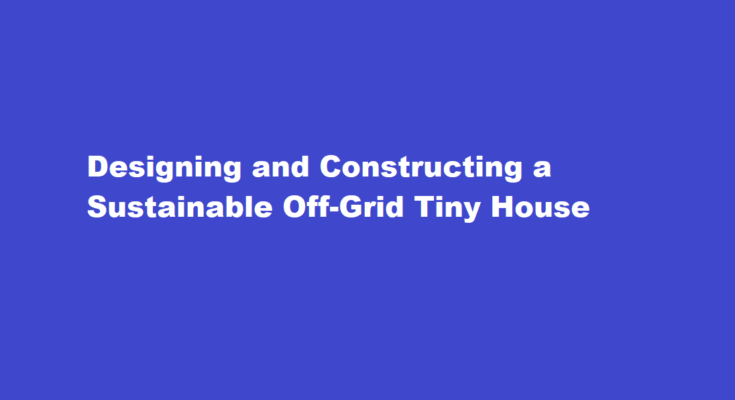Introduction
The concept of living sustainably has gained significant momentum in recent years, prompting many to explore alternative housing options such as off-grid tiny houses. These small, eco-friendly dwellings offer a way to minimize our ecological footprint while maximizing self-sufficiency and simplicity. In this article, we will delve into the essential steps and considerations for designing and constructing a sustainable off-grid tiny house, focusing on energy efficiency, water conservation, materials, and lifestyle choices that contribute to a harmonious coexistence with nature.
Planning and Design
The first step in building a sustainable off-grid tiny house is meticulous planning and thoughtful design. Start by determining your specific needs and preferences, such as the number of occupants, daily energy usage, and desired amenities. Embrace the principles of minimalism and multifunctionality to optimize space utilization. Orient the house to maximize passive solar gain and natural ventilation while minimizing exposure to harsh elements. To reduce energy consumption, use energy-efficient appliances and LED lighting, and consider integrating renewable energy sources like solar panels or wind turbines.
Eco-Friendly Materials
Selecting eco-friendly and sustainable materials is crucial to reducing the environmental impact of your tiny house. Opt for reclaimed, recycled, or locally-sourced materials whenever possible, minimizing the energy required for transportation and production. Utilize natural and non-toxic materials for insulation, such as straw bales or recycled denim, to improve thermal performance and indoor air quality. Incorporate sustainable wood, bamboo, or cork for flooring, cabinetry, and furniture. Additionally, explore alternative construction techniques like rammed earth or adobe to further enhance sustainability.
Off-Grid Energy Solutions
Achieving energy independence is a central aspect of an off-grid tiny house. Installing solar panels on the roof or an adjacent structure allows you to harness the sun’s energy and store it in batteries for use during cloudy days or at night. Consider a backup power source like a small generator or a wind turbine in regions with ample wind resources. Implement energy-efficient appliances and lighting to minimize consumption. Smart energy management systems can optimize power usage, reducing waste and extending battery life. Prioritize passive heating and cooling strategies to further minimize energy needs.
Water Management and Conservation
Implementing a robust water management system is vital for an off-grid tiny house. Install rainwater harvesting systems to collect and store rainwater for daily needs and irrigation. Use low-flow fixtures and composting toilets to reduce water consumption significantly. Greywater recycling can further optimize water usage by reusing water from sinks and showers for non-potable purposes like flushing toilets or watering plants.
Waste Reduction and Recycling
Embrace a waste-conscious lifestyle by adopting practices such as composting organic waste and reducing single-use items. Integrate recycling bins within the tiny house to encourage responsible waste disposal. Choose durable and long-lasting materials that won’t require frequent replacement, reducing waste over the house’s lifetime. Consider repurposing or upcycling materials for furniture and decor, adding a unique touch to the interior while reducing the demand for new resources.
FREQUENTLY ASKED QUESTIONS
Are tiny houses legal in the UK?
ANS: If a tiny house doesn’t have a trailer, then it could be classified as either a granny annexe / ancillary building / compact house and even a caravan still as the term does not cover a structure built for human habitation to ‘must’ have a trailer. Whatever classification it comes under, tiny houses are legal in the UK.
What do you put under a tiny house?
ANS: A concrete slab foundation is a simple pad made by first creating a wood frame called a form. Then you fill the form frame with concrete to form a slab. In some instances, you’ll lay in rebar or wire mesh to reinforce the pad, but that isn’t always necessary.
Conclusion
Designing and constructing a sustainable off-grid tiny house requires careful planning, eco-friendly materials, and a commitment to sustainable living. Embrace renewable energy sources, efficient water management, and waste reduction strategies to create a harmonious and environmentally friendly dwelling that exemplifies a greener way of life.
Read Also : Organising a Thrilling Community-Wide Treasure Hunt A Step-by-Step Guide to Success



